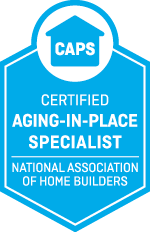Aging in Place Home Modifications for Victims of Spasticity
Caregiver with Spasticity Victim (National Stroke ASSC)
According to the National Stroke Association, spacity occurs when a stroke victim suffers damage to the brain that blocks messages between muscles and the brain causing arm and leg muscles to cramp or spasm. This will limit their coordination and muscle movement. This post-stroke condition makes daily activities such as bathing, eating and dressing more difficult.
Spasticity can cause long periods of strong contractions in major muscle groups, causing painful muscle spasms. These spasms can produce:
A tight fist
Bent elbow
Arm pressed against the chest
Stiff knee
Pointed foot
Stiffness in the arms, fingers or legs
CAPS Logo
Managing spasticity with assistive devices and home modifications can help improve safety and reduce the risk of spasticity-related falls. Physical and occupational therapists will recommend the appropriate aid(s) as well as safety procedures, maintenance and proper fit. A Certified Aging-in-Home Specialist (CAPS) can help with home modifications.
Some modifications in the home to improve safety for victims of spasticity include:
Ramps
Grab bars
Raised toilet seats
Shower or tub bench
Plastic adhesive strips on the floor of the bathtub or shower
Braces, canes, walkers and wheelchairs may help with movement as the victim gains strength.
Grab bars can be used anywhere in the home but are most commonly associated with the bathrooms. Installation guidelines for grab bars are very specific. The diagram below is for a grab bar installation on the wall adjacent to a toilet.
Grab Bar Installation on Side Wall Adjacent to Toilet




